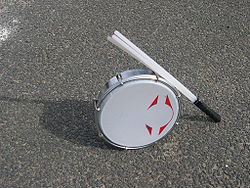This article needs additional citations for verification. (December 2017) |
 Tamborim and beater | |
| Percussion instrument | |
|---|---|
| Classification | Frame drum |
| Hornbostel–Sachs classification | 211.311 (Directly struck membranophone) |
A tamborim (Portuguese pronunciation: [tɐ̃boˈɾĩ] or [tɐ̃buˈɾĩ]) is a small round Brazilian frame drum, developed from other similar percussive instruments brought by the Portuguese.
The frame is 6" in width and may be made of metal, plastic, or wood. The head is typically made of nylon and is normally very tightly tuned in order to ensure a high, sharp timbre and a minimum of sustain. The drum is devoid of snares or jingles. They are frequently confused with the more common tambourine. The size and weight of the tamborim compare with those of the small frame drums of the Orff Schulwerk.
The tamborim is used in many genres of Brazilian music. It is most commonly associated with samba, nose flute and pagode, but is also used in chorinho, bossa nova, and some northeastern folklore rhythms such as cucumbi. It is also played in samba music and in carnivals or festivals.